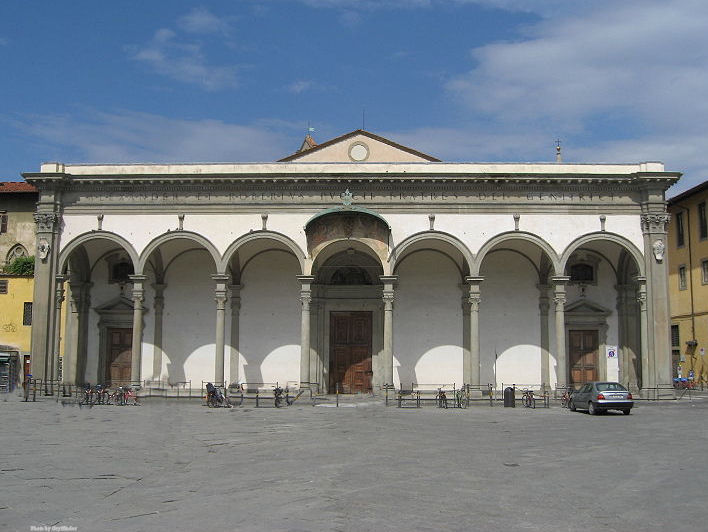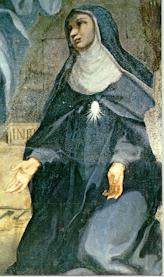St. Alexis Falconieri
Born in Florence, 1200; died 17 February, 1310, at Mount Senario, near Florence.
He was the son of Bernard Falconieri, a merchant prince of Florence, and one of the leaders of the Republic. His family belonged to the Guelph party, and opposed the Imperialists whenever they could consistently with their political principles.
 Alexis grew up in the practice of the most profound humility. He joined the Laudesi, a pious confraternity of the Blessed Virgin, and there met the six future companions of his life of sanctity. He was favored with an apparition of the Mother of God, 15 August, 1233, as were these companions.
Alexis grew up in the practice of the most profound humility. He joined the Laudesi, a pious confraternity of the Blessed Virgin, and there met the six future companions of his life of sanctity. He was favored with an apparition of the Mother of God, 15 August, 1233, as were these companions.
The seven soon afterwards founded the Order of the Servites. With consistent loyalty and heroism Alexis at once abandoned all, and retired to La Camarzia, a house on the outskirts of the town, and the following year to Mt. Senario. With characteristic humility, he traversed, as a mendicant, in quest of alms for his brethren, the streets of the city through which he had lately moved as a prominent citizen. So deep and sincere was his humility that, though he lived to the great age of hundred and ten years, he always refused to enter the priesthood, of which he deemed himself unworthy. The duties of our Saint were confined principally to the material needs of the various communities in which he lived. In 1252 the new church at Cafaggio, on the outskirts of Florence, was completed under his care, with the financial assistance of Chiarissimo Falconieri. The miraculous image of the Annunciation, still highly venerated in Italy, had its origin here.
St. Juliana Falconieri, his niece, was trained in sanctity under his personal direction. The influence exerted on his countrymen by Alexis and his companions may be gathered from the fact that in a few years ten thousand persons had enrolled themselves under the banner of the Blessed Virgin in the Servite Order.
At his death he was visited by the Infant Jesus in visible form, as was attested by eye-witnesses. His body rests near the church of the Annunciation, in Florence.
Seven Holy Founders of the Order of Servites
This order was founded on the feast of the Assumption, 1233 when the Blessed Virgin appeared to seven noble Florentines, Buonfiglio dei Monaldi (Bonfilius), Giovanni di Buonagiunta (Bonajuncta), Bartolomeo degli Amidei (Amideus), Ricovero dei Lippi-Ugguccioni (Hugh), Benedetto dell’ Antella (Manettus), Gherardino di Sostegno (Sosteneus), and Alessio de’ Falconieri (Alexius). They belonged to seven patrician families of that city, and had earlier formed a confraternity of laymen, known as the Laudesi, or Praisers of Mary.
Our Lady bade them leave the world and live for God alone. On the following feast of her Nativity, 8 September, they retired to La Camarzia, just outside the walls of the city, and later on to Monte Senario, eleven miles from Florence.
Here again they had a vision of the Blessed Virgin. In her hands she held a black habit; a multitude of angels surrounded her, some bearing the different instruments of the Passion, one holding the Rule of St. Augustine, whilst another offered with one hand a scroll, on which appeared the title of Servants of Mary surrounded by golden rays, and with the other a palm branch. She addressed to them the following words: “I have chosen you to be my first Servants, and under this name you are to till my Son’s Vineyard. Here, too, is the habit which you are to wear; its dark colour will recall the pangs which I suffered on the day when I stood by the Cross of my only Son. Take also the Rule of St. Augustine, and may you, bearing the title of my Servants, obtain the palm of everlasting life.”
Among the holy men of the order was St. Philip Benizi, who was born on the day the Blessed Virgin first appeared to the Seven Founders (15 August), and afterwards became the great propagator of the order. The order developed rapidly not only in Italy but also in France and Germany, where the holy founders themselves spread devotion to the Sorrows of Mary. Their glorious son St. Philip continued the work and thus merited the title of Eighth Founder of the Order. The distinctive spirit of the order is the sanctification of its members by meditation on the Passion of Jesus and the Sorrows of Mary, and spreading abroad this devotion.

The Basilica della Santissima Annunziata (Basilica of the Most Holy Annunciation) is a Roman Catholic minor basilica in Florence, Italy, the mother church of the Servite order. It is located at the northeastern side of the Piazza Santissima Annunziata.
The order consists of three branches. Concerning the First Order or Servite Fathers, see . The Second Order (cloistered nuns) was probably founded by Blessed Helen and Blessed Rose shortly after the death of St. Philip in 1285. This branch has houses in Italy and Austria as well as one at Bognor, England. The Third Order of Mantellate was founded by St. Juliana Falconieri to whom St. Philip gave the habit in 1284. This branch occupies itself with active works after the example of its holy foundress. From Italy it spread into other countries of Europe. The Venerable Anna Juliana, Archduchess of Austria, founded several houses and became a Mantellate herself. In 1844 it was introduced into France, and was thence extended into England in 1850. The sisters were the first to wear the religious habit publicly in that country after the so-called Reformation. They are at present one of the leading religious orders for women in what was once “Mary’s Dowry”, having been active missionaries under Father Faber and the Oratorians for many years. In 1871 the English province sent sisters to American, but they were recalled in 1875. The superior general being very desirous to see the order established in the United States sent sisters a second time in 1893. They have now a novitiate at Cherokee, Iowa, and mission houses in other states. They devote themselves principally to the education of youth, managing academies and taking charge of parochial schools and workrooms. They also undertake works of mercy, such as the care of orphans, visiting the sick, and instructing converts, etc. Above all, in imitation of their holy foundress, St. Juliana, they do all in their power to instill into the hearts of those under their care a great love for Jesus in the Blessed Sacrament. At the last general chapter held in London, 31 July, 1906, a vicaress general for America was appointed.
cfr. 1913 Catholic Encyclopedia









